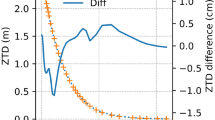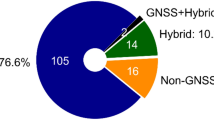Abstract
Low Earth orbit (LEO) constellations have potentialities to augment global navigation satellite systems for better service performance. The prerequisite is to provide the broadcast ephemerides that meet the accuracy requirement for navigation and positioning. In this study, the Kepler ephemeris model is chosen as the basis of LEO broadcast ephemeris design for backward compatibility and simplicity. To eliminate the singularity caused by the smaller eccentricity of LEO satellites compared to MEO satellites, non-singular elements are introduced for curve fitting of parameters and then transformed to Kepler elements to assure the algorithm of ephemeris computation remains unchanged for the user. We analyze the variation characteristics of LEO orbital elements and establish suitable broadcast ephemeris models considering fit accuracy, number of parameters, fit interval, and orbital altitude. The results of the fit accuracy for different fit intervals and orbital altitudes suggest that the optimal parameter selections are \((Crs3,Crc3)\), \((Crs3,Crc3, \, \dot{a},\dot{n})\) and \(\left( {Crs3,Crc3, \, \dot{a},\dot{n}, \, \ddot{i},\ddot{a}} \right)\), i.e., adding two, four or six parameters to the GPS 16-parameter ephemeris. When adding four parameters, the fit accuracy can be improved by about one order of magnitude compared to the GPS 16-parameter ephemeris model, and fit errors of less than 10 cm can be achieved with 20-min fit interval for a 400–1400 km orbital altitude. In addition, the effects of the number of parameters, fit interval, and orbit altitude on fit accuracy are discussed in detail. The validation with four LEO satellites in orbit also confirms the effectiveness of proposed models.






Similar content being viewed by others
References
Brouwer D, Clemence GM, Chako N (2005) Methods of celestial mechanics. Springer, Berlin
Chen L, Jiao W, Huang X, Geng C, Ai L, Lu L, Hu Z (2013) Study on signal-in-space errors calculation method and statistical characterization of BeiDou navigation satellite system. Proc China Satell Navig Conf 2013:423–434
CSNO (2013) BeiDou navigation satellite system signal in space interface control document-open service signal. Version 2.0, 26 December 2013, China Satellite Navigation Office (CSNO)
Cui X (2006) Comparisons of two kinds of GPS broadcast ephemeris parameter algorithms. Chin J Sp Sci 26(5):382–387
Dierendonck AJV, Russell SS, Kopitzke ER, Birnbaum M (1978) The GPS navigation message. Navigation 25(2):147–165
Diesposti R, Dilellio J, Kelley C, Dorsey A, Fliegel H, Berg J, Edgar C, Mckendree T, Shome P (2004) The proposed state vector representation of broadcast navigation message for user equipment implementation of GPS satellite ephemeris propagation. In: Proceedings of the ION NTM 2004, pp 294–312. Institute of Navigation, San Diego, California, USA, 26–28 Jan
Du L, Zhang Z, Zhang J, Liu L, Guo R, He F (2014) An 18-element GEO broadcast ephemeris based on non-singular elements. GPS Solut 19(1):49–59
EU (2015) European GNSS (Galileo) open service signal in space interface control document. Issue 1.2, November 2015. European Union
Fang S, Du L, Zhou P, Lu Y, Zhang Z, Liu Z (2016) Orbital list ephemerides design of LEO navigation augmentation satellite. Acta Geod Cartogr Sin 45(8):904–910
Fu X, Wu M (2011) Optimal design of broadcast ephemeris parameters for a navigation satellite system. GPS Solut 16(4):439–448
Gilthorpe MS, Moore P (1992) A combined theory for zonal harmonic and resonance perturbations of a near-circular orbit with applications to COSMOS 1603 (1984-106A). Celest Mech Dyn Astron 54(4):363–391
GPS Directorate (2013) Navstar GPS space segment/navigation user interfaces. Interface specification, IS-GPS-200H, Version H, September 23, 2013, Global Positioning Systems Directorate
Guo J, Zhao Q, Guo X, Liu X, Liu J, Zhou Q (2015) Quality assessment of onboard GPS receiver and its combination with DORIS and SLR for Haiyang 2A precise orbit determination. Sci China Earth Sci 58(1):138–150
He F, Hu X, Liu L, Huang H, Zhou S, Wu S, Gu L, Zhao H, Liu X (2014) Fitting method and accuracy analysis of broadcast ephemeris in hybrid constellation. Proc China Satell Navig Conf 2014:265–275
Heng L, Gao G, Walter T, Enge P (2011) Statistical characterization of GLONASS broadcast ephemeris errors. In: Proceedings of the ION GNSS 2011, pp 3109–3117. Institute of Navigation, Portland, Oregon, USA, 19–23 Sept
Hintz GR (2008) Survey of orbit element sets. J Guid Control Dyn 31(3):785–790
Horemuž M, Andersson JV (2006) Polynomial interpolation of GPS satellite coordinates. GPS Solut 10(1):67–72
Hu Z, Chen G, Zhang Q, Guo J, Su X, Li X, Zhao Q, Liu J (2013) An initial evaluation about BDS navigation message accuracy. Proc China Satell Navig Conf 2013:479–491
Hugentobler U, Montenbruck O (2017) Satellite orbits and attitude, Chap. 3. In: Teunissen PJG, Montenbruck O (eds) Springer handbook of global navigation satellite systems. Springer, Berlin
ICD-GLONASS (2016) Global navigation satellite system GLONASS, interface control document, general description of code division multiple access signal system. Edition 1.0, Russian Institute of Space Device Engineering
JAXA (2014) Quasi-Zenith satellite system navigation service interface specification for QZSS. IS-QZSS V1.6, November 28, 2014, Japan Aerospace Exploration Agency
Joerger M, Neale J, Pervan B (2009) Iridium/GPS carrier phase positioning and fault detection over wide areas. In: Proceedings of the ION GNSS 2009, pp 1371–1385. Institute of Navigation, Savannah, Georgia, USA, 22–25 Sept
Joerger M, Gratton L, Pervan B, Cohen CE (2010) Analysis of iridium-augmented GPS for floating carrier phase positioning. Navigation 57(2):137–160
Liu J, Ge M (2003) PANDA software and its preliminary result of positioning and orbit determination. Wuhan Univ J Nat Sci 8(2B):603–609
Montenbruck O, Gill E (2000) Satellite orbits: models, methods, and applications. Springer, Berlin
Montenbruck O, Steigenberger P, Hauschild A (2014) Broadcast versus precise ephemerides: a multi-GNSS perspective. GPS Solut 19(2):321–333
Piscane VL, Holland BB, Black HD (1973) Recent (1973) improvements in the navy navigation satellite system. Navigation 20(3):224–229
Rabinowitz M, Spilker JJ (2005) A new positioning system using television synchronization signals. IEEE Trans Broadcast 51(1):51–61
Reid TGR, Walter T, Enge PK, Sakai T (2015) Orbital representations for the next generation of satellite-based augmentation systems. GPS Solut 20(4):737–750
Reid TGR, Neish A, Walter T, Enge PK (2016) Leveraging commercial broadband LEO constellations for navigation. In: Proceedings of the ION GNSS + 2016, pp 2300–2314. Institute of Navigation, Portland, Oregon, USA, 12–16 Sept
Thomas A, Stansell JR (1968) The navy navigation satellite system: description and status. Navigation 15(3):229–243
Tian S, Dai W, Liu R, Chang J, Li G (2014) System using hybrid LEO-GPS satellites for rapid resolution of integer cycle ambiguities. IEEE Trans Aerosp Electron Syst 50(3):1774–1785
Warren DL, Raquet JF (2003) Broadcast vs. precise GPS ephemerides: a historical perspective. GPS Solut 7(3):151–156
Xu G, Xu Y (2007) GPS: theory, algorithms and applications. Springer, Berlin
Xu G, Xu J (2013) On the singularity problem in orbital mechanics. Mon Not R Astron Soc 429(2):1139–1148
Yin H, Morton Y, Carroll M, Vinande E (2015) Performance analysis of L2 and L5 CNAV broadcast ephemeris for orbit calculation. Navigation 62(2):121–130
Acknowledgements
This work is supported by the National Nature Science Foundation of China (Nos. 41674004, 41574030) and Fundamental Research Funds for the Central Universities (No. 2042016kf0185).
Author information
Authors and Affiliations
Corresponding author
Rights and permissions
About this article
Cite this article
Xie, X., Geng, T., Zhao, Q. et al. Design and validation of broadcast ephemeris for low Earth orbit satellites. GPS Solut 22, 54 (2018). https://doi.org/10.1007/s10291-018-0719-9
Received:
Accepted:
Published:
DOI: https://doi.org/10.1007/s10291-018-0719-9




